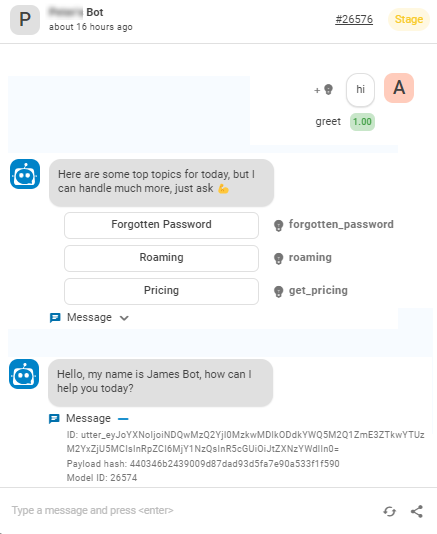このページでは、でのMpowerエージェント![]() CXone MpowerのAgent Builderを使用して作成された、音声またはチャットのインタラクションに対応できるバーチャルエージェント。Agent Builderのテストについて説明します。 これは、Mpowerエージェント 実装プロセスの4番目のステップです。
CXone MpowerのAgent Builderを使用して作成された、音声またはチャットのインタラクションに対応できるバーチャルエージェント。Agent Builderのテストについて説明します。 これは、Mpowerエージェント 実装プロセスの4番目のステップです。
| コンセプト | 定義 | 例 | Mpowerエージェントの機能 |
|---|---|---|---|
|
発話 |
コンタクト |
「パスワードを紛失しました。」 「私の残高は?」 「あなたはボットですか?」 |
Mpowerエージェントは自然言語理解(NLU)を使用して、各コンタクトの発話を分析し、その意味、つまりインテントを判断します。 |
|
インテント |
コンタクトが伝えたいこと、または達成したいこと。 コンタクトが送信するすべてのメッセージにはインテントがあります。 |
「パスワードを紛失しました」は「パスワードの再設定」というインテントがあります。 「こんにちは」は「挨拶」のインテントがあります。 |
Mpowerエージェントは、NLU |
|
エンティティ |
コンタクトのメッセージ中の定義済み情報。 | 個人または製品名、電話番号、アカウント番号、場所など。 | Mpowerエージェントは、NLUを使用して、コンタクトのメッセージ内のエンティティを識別します。 エンティティ、Mpowerエージェントがコンタクトのメッセージの意味を理解するのに役立ちます。 |
|
スロット |
コンタクトのメッセージから抽出され、Mpowerエージェント応答で使用するために保存されたエンティティ。 変数に似たもの。 | コンタクト名のスロットを作成すると、Mpowerエージェントは対話中の応答でその名前を使用できるようになり、より個人的な名前になります。 | そのように構成されている場合、Mpowerエージェントは連絡先メッセージからエンティティを抽出し、スロットに保存します。 会話の後半でMpowerエージェントにこの情報を使用させることができます。 |
|
ルール |
文脈によって意味が変わらないメッセージに対するMpowerエージェント応答を定義します。 |
|
ルールは、Mpowerエージェントがインテントにどのように応答するかを設定する2つの方法のうちの1つです。 ルールはある種のインテントには有効ですが、すべてのインテントに有効なわけではありません。 |
|
ストーリー |
メッセージの意図と会話のコンテキストに基づいてインタラクションを処理するようにMpowerエージェントをトレーニングします。 | パスワードを忘れた場合のやり取りで、Mpowerエージェントは「どうすればいいですか?」と答えます。 場合があります。 インタラクションが新しいアカウントの作成に関するものであった場合、どちらの場合も、コンタクトが同じ意図で同じ単語を使用していても、応答はまったく異なります。 | ストーリーは、Mpowerエージェントがインテントにどのように応答するかを設定できる2つの方法のうちの2つ目の方法です。 ストーリーは、会話の文脈を利用して適切に応答する方法をMpowerエージェントに教えます。 |
|
Mpowerエージェントアクション |
インタラクションの処理中にMpowerエージェントが言ったり行ったりすること。 |
パスワードを忘れた場合のやり取りでは、MpowerエージェントはWebサイトのパスワードリセットに関するFAQへのリンクを送信して応答します。 コンタクトが「理解できない」などと不満を表明した場合! 機能していません!」 Mpowerエージェントは「ごめんなさい。 人間のエージェントに転送しましょうか?」と応答します。 コンタクトが「はい」と答えると、Mpowerエージェントが転送を開始します。 |
Mpowerエージェントアクションは、Mpowerエージェントが各インテントにどのように応答するかを定義する際のオプションです。 各レスポンスを柔軟に設定することで、コンタクトのニーズに合ったアウトカムを達成することができます。 |
会話でMpowerエージェントをテストする
Mpowerエージェントと会話をすることは、それをテストするための最良の方法です。 これにより、インテント![]() コンタクトが発言または入力した内容の背後にある意味や目的。コンタクトが伝えたいことや達成したいこと。をどれだけうまく予測するかを直接観察できます。 Mpowerエージェントがインテントを誤って予測したり、信頼度が低い場合は、調整を行ってすぐに結果を確認できます。
コンタクトが発言または入力した内容の背後にある意味や目的。コンタクトが伝えたいことや達成したいこと。をどれだけうまく予測するかを直接観察できます。 Mpowerエージェントがインテントを誤って予測したり、信頼度が低い場合は、調整を行ってすぐに結果を確認できます。
の組み込みのチャットウィンドウを使用して、MpowerエージェントとAgent Builderチャットできます。 このチャットウィンドウは、本番のチャットでは利用できない追加情報を提供します。 テスト会話を進めながらこの情報を使用して、Mpowerエージェント応答構成でいつ変更が必要かを判断できます。
たとえば、次の画像では、テストユーザーのメッセージのインテント予測と、Mpowerエージェントレスポンスの各クイックリプライオプションに割り当てられたインテントが示されていることがわかります。 Mpowerエージェントが送信する各メッセージの下には、テスト対象のMpowerエージェント モデル![]() トレーニングされ、ステージングされたボットのバージョンやメッセージ ID など、メッセージに関する情報を含むドロップダウンがあります。 インサイトの[会話]タブで会話を表示する際にも、同じ情報を確認できます。
トレーニングされ、ステージングされたボットのバージョンやメッセージ ID など、メッセージに関する情報を含むドロップダウンがあります。 インサイトの[会話]タブで会話を表示する際にも、同じ情報を確認できます。
テストに使用する会話は、実際のインタラクションで使われたものでなければなりません。 これらの会話をMpowerエージェントで再現することで、どのように処理されるかをテストできます。 まずは、実装プロセスの前の段階で収集した例を使用することから始めることができます。 新しいトレーニング例を集めて、それを使うこともできます。


